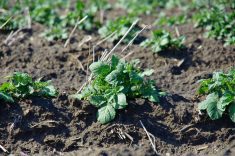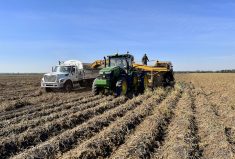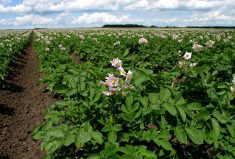Alberta’s potato industry has bounced right back from its dip in acres during the pandemic.

“We’re back to the 2019 acres,” said Terence Hochstein, executive director of the Potato Growers of Alberta.
“We’ve added a few more acres, but there’s really no new farms and no huge increases on any particular farm. It’s just getting back to pre-COVID levels.”
Still, Alberta and Manitoba have become the tag-team champions in the Canadian spud industry.
This year, the two Prairie provinces planted a combined 146,000 acres. That edged them past the longtime leaders in the Maritimes — P.E.I. and New Brunswick — where just under 138,000 acres were planted, according to United Potato Growers of Canada estimates.
And while P.E.I. is still tops in acreage, its production has been flat while both Alberta and Manitoba have seen significant jumps in the last five years thanks to new or expanded french fry plants. (Cavendish Farms opened its $430-million facility in Lethbridge in 2019 while Simplot doubled the size of its Portage la Prairie, Man. operation.)
Read Also

Hail research hopes to benefit potato growers
Alberta research scientist measures hail storm and heat dome affects on potato crops
Across Canada, growers increased their potato acreage by 5.3 per cent this year, according to July estimates from Statistics Canada. Those increases were highest in Alberta, where growers planted an additional 7,823 acres this year — an increase of 13.1 per cent over 2020.
But that jump really only fills the gap left by last year’s lower acres, said Hochstein. One processor, for instance, cut their contracted acres by 30 per cent last year as a result of global shutdowns.
“During COVID, we didn’t eat as much french fries as we did before,” he noted. “Restaurants shut down and consumers weren’t eating as much as they were. So it’s not like we’ve added a bunch of acres.”
This year’s gains have been incremental, with farms adding an extra (irrigation) circle here or there, he added.
“They’re not huge acres, but when you add it all up, you get that 7,000-acre increase.”
That’s likely how the potato industry will continue to grow — slowly and steadily over time. But the $815-million expansion of southern Alberta’s irrigation system announced earlier this year could speed up that process.
“Growth will depend on what acres become available through the irrigation expansion,” said Hochstein. “It’s not like we’re going to pick up and go into a new area — we’re just going to expand the area that’s there. So it’s going to depend on the areas that have land available.”
Right now, processing potatoes are mostly grown in a triangle from Coaldale east to Bow Island and north toward Brooks. Coaldale is home to McCain Foods french fry plant while the third major plant is Lamb Weston’s facility in Taber.
Hochstein said he expects that triangle will expand as improvements to the irrigation system are completed over the next decade.
“There is potential to increase some potato acres once these projects are completed, but the big project in the south is the expansion of the Chin Reservoir, and that’s 10 years in the making,” he said.
“I think there will be expanded acres in time, but this is going to take a lot of time.”
The improved irrigation system — and its potential for increased production — is also likely to attract more processing to the area. Southern Alberta potato growers are already seeing that thanks to the new Cavendish Farms facility.
“As Cavendish continues to get that plant fully utilized, we’re going to see some more acres over the next four to five years,” said Hochstein.
“That new plant in Lethbridge is capable of producing two million pounds of frozen french fries in a day.
“Are we there yet? No. But are we getting close? Yes. And that adds up.”
But most of that growth is likely to come from existing farms, he added. For farmers who aren’t already growing spuds, it’s simply too expensive to break into the industry.
“It’s literally tens of millions of dollars of investment to get into this industry, so probably 90 per cent of that will be expansion of existing operations,” said Hochstein.
“It’s a very expensive crop to grow. Land prices are part of it, but the cost of your equipment and your storage facilities are high, too.
“There might be the odd new person who gets into the business, but you’d better have a very friendly banker if you want to play in this game.”















